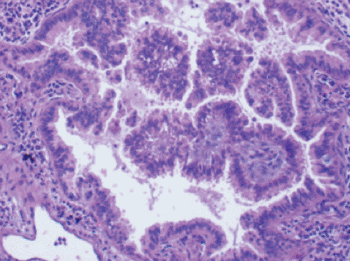Blood Test Differentiates Benign Lung Nodules from Lung Cancer
By LabMedica International staff writers
Posted on 28 Nov 2013
A combination of quantifiable blood proteins can distinguish between benign lung nodules and early-stage lung cancer with high probability.Posted on 28 Nov 2013
This multiple protein expression classifier, which is intended to assist physicians with the early diagnosis of lung nodules, uses a highly sensitive analytic technique called multiple reaction monitoring mass spectroscopy (MRM-mass spec).

Image: Histology of a lung nodule excision showing papillary adenocarcinoma (Photo courtesy of iCytology).
A team of scientists led by those at Integrated Diagnostics (Seattle, WA, USA) used laboratory-based analytical method, combined with sophisticated bioinformatics and systems-biology approaches to assess the diagnostic power of 371 potential lung cancer biomarkers in millions of different combinations before settling on the diagnostic classifier, a set of biomarkers that the data indicates is most effective.
The team collected plasma samples from 143 patients from three sites to study the diagnostic value of various combinations of biomarkers. They came from patients with either benign nodules or Stage IA lung cancer, matched for nodule size, age, gender, and clinical site. The sample matching strategy yielded a classifier whose results are independent of a patient’s age, smoking history, or nodule size. Therefore, the resulting classifier has the potential to complement each of the risk factors that are currently used in the clinical assessment of lung nodules.
The final group of 13 proteins was validated in a second study that utilized an independent set of 104 plasma samples, 52 with cancer and 52 benign, and included successful validation of the classifier at a completely new hospital site. As with the earlier study, each malignant sample was matched with a benign sample of the same age, gender, nodule size and participating clinical site. In this study, the classifier was found to have a negative predictive value (NPV) of 90%. This implies that for patients whose test results identify protein markers at certain concentrations, their nodule is probably benign, and this has a high probability of that classification being correct.
Leroy Hood, MD, PhD, a coauthor of the study, said, “This study suggests the tremendous power of using systems biology and bioinformatics to better understand health and disease. These systems approaches convert blood into a window that will readily allow us to distinguish health from disease, and if disease, which disease. This is just the beginning. The principles used to develop this classifier should be applicable to a range of unmet diagnostic medical needs.” The study was published on October 16, 2013, in the journal Science Translational Medicine.
Related Links:
Integrated Diagnostics




 assay.jpg)









